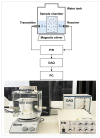Noninvasive Estimation of Tumor Interstitial Fluid Pressure from Subharmonic Scattering of Ultrasound Contrast Microbubbles
- PMID: 37232888
- PMCID: PMC10216054
- DOI: 10.3390/bios13050528
Noninvasive Estimation of Tumor Interstitial Fluid Pressure from Subharmonic Scattering of Ultrasound Contrast Microbubbles
Abstract
The noninvasive estimation of interstitial fluid pressure (IFP) using ultrasound contrast agent (UCA) microbubbles as pressure sensors will provide tumor treatments and efficacy assessments with a promising tool. This study aimed to verify the efficacy of the optimal acoustic pressure in vitro in the prediction of tumor IFPs based on UCA microbubbles' subharmonic scattering. A customized ultrasound scanner was used to generate subharmonic signals from microbubbles' nonlinear oscillations, and the optimal acoustic pressure was determined in vitro when the subharmonic amplitude reached the most sensitive to hydrostatic pressure changes. This optimal acoustic pressure was then applied to predict IFPs in tumor-bearing mouse models, which were further compared with the reference IFPs measured using a standard tissue fluid pressure monitor. An inverse linear relationship and good correlation (r = -0.853, p < 0.001) existed between the subharmonic amplitude and tumor IFPs at the optimal acoustic pressure of 555 kPa, and pressure sensitivity was 1.019 dB/mmHg. No statistical differences were found between the pressures measured by the standard device and those estimated via the subharmonic amplitude, as confirmed by cross-validation (mean absolute errors from 2.00 to 3.09 mmHg, p > 0.05). Our findings demonstrated that in vitro optimized acoustic parameters for UCA microbubbles' subharmonic scattering can be applied for the noninvasive estimation of tumor IFPs.
Keywords: interstitial fluid pressure; subharmonic scattering; ultrasound contrast agent microbubbles.
Conflict of interest statement
The authors declare no conflict of interest.
Figures







References
-
- Boucher Y., Jain R.K. Microvascular pressure is the principal driving force for interstitial hypertension in solid tumors: Implications for vascular collapse. Cancer Res. 1992;52:5110–5114. - PubMed
MeSH terms
Substances
Grants and funding
LinkOut - more resources
Full Text Sources
Medical
Miscellaneous

